The sample disk is a round, thick disk, into which six lunar soil and rock samples are cast in plastic. Photographic conditions were not ideal because of surface imperfections in the plastic, and because parts of the plastic have non-uniform refractive indexes. These samples were photographed with oblique incident light against a neutral gray background. Most photos were through the back of the disk, which gave a clearer view.
Anorthosite

Much of the lunar crust is made of plagioclase-rich anorthosite and related rocks. All anorthosite samples returned from the moon are highly fractured as a result of their long history of impact shocks. Hence, anorthosite samples are typically small and cloudy-white. White is plagioclase, brown is pyroxene, and the black specks are opaques. Field width is 14 mm.
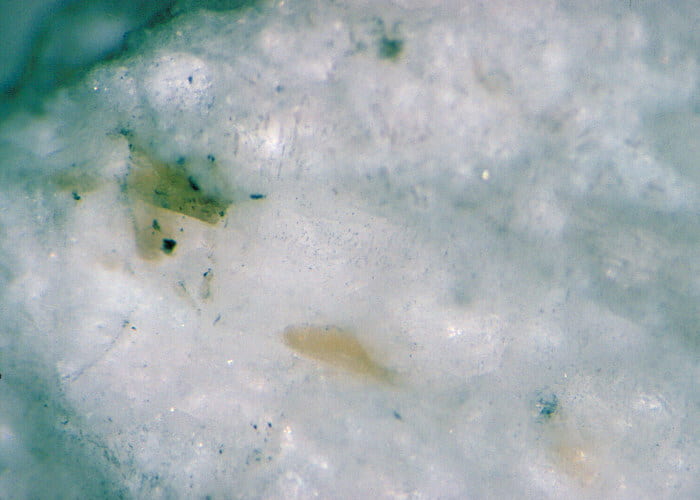
This is a close-up of the sample above, showing detail of the small pyroxene crystals and arrays of opaques in the plagioclase crystals. Such arrays of opaques and other minerals exsolved from the high temperature plagioclase solid solution are common in terrestrial anorthosites. Notice that larger opaque grains are clustered around pyroxene. This clustering probably represents crystallization of trapped interstitial residual liquid, rich in Fe, Ti, and other incompatible components. Field width is 6.5 mm.
Basalt
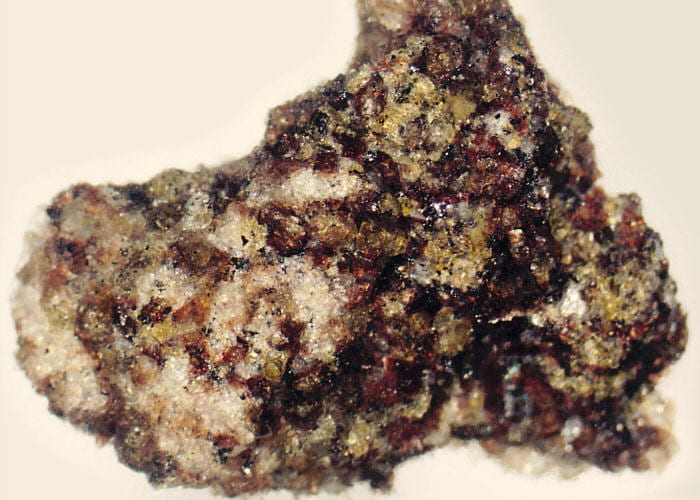
Basalts are most extensively exposed as thick sequences of lava flows on the floors of the lunar maria. Although basalts are found elsewhere, the bulk of them occupy the floors and margins of these large impact basins. The sample here has white plagioclase, green olivine, brown pyroxene, and black opaques that are mostly Fe-Ti oxides. Because the basalts are generally younger than the anorthosites, the basalts tend to be less damaged by impact shocks. Field width is 22 mm.
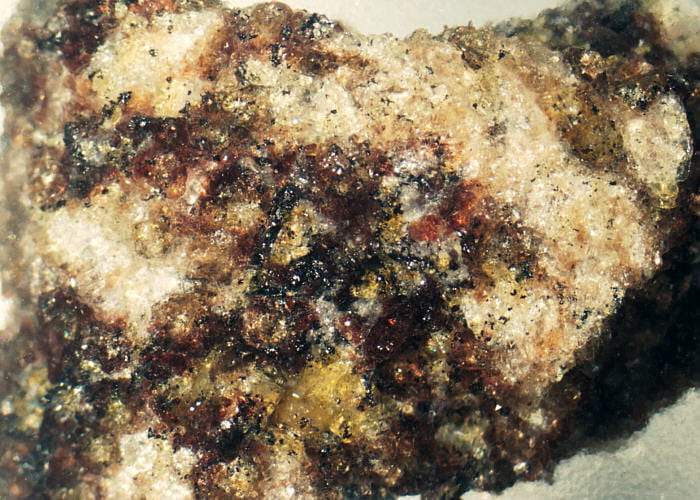
Close-up of the sample above, showing the distinctively plum-colored pyroxenes and olive-green olivine. Plagioclase is obviously more highly fractured than is the pyroxene and olivine. Field width is 12 mm.
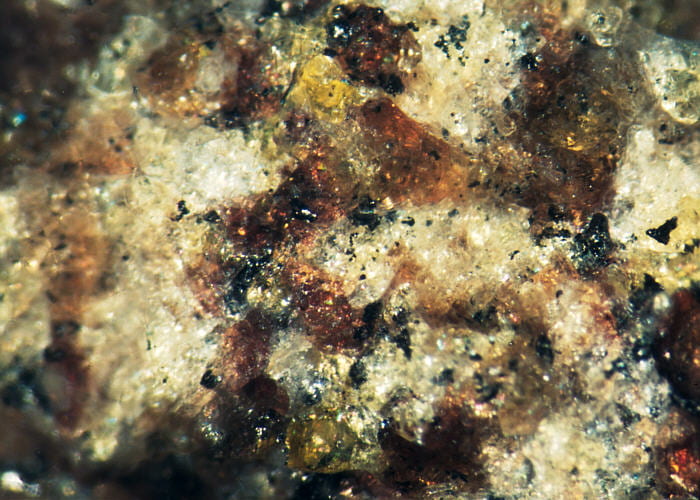
Close-up of the sample above, showing discrete grains of olivine, pyroxene, opaques, and plagioclase. Field width is 8 mm.
Highland regolith
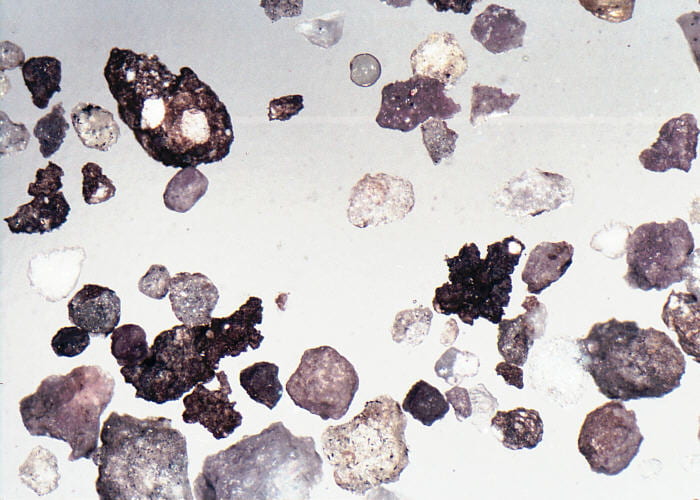
Highland soil is rich in plagioclase fragments and plagioclase-rich breccias. Visible here are white, highly fractured plagioclase (left-center, right center) and a small feldspathic breccia fragment (upper left). The medium-gray fragments are feldspathic rocks also. The irregular dark fragments scattered about (e.g., bottom center) are agglutinate grains. Field width is 14 mm.
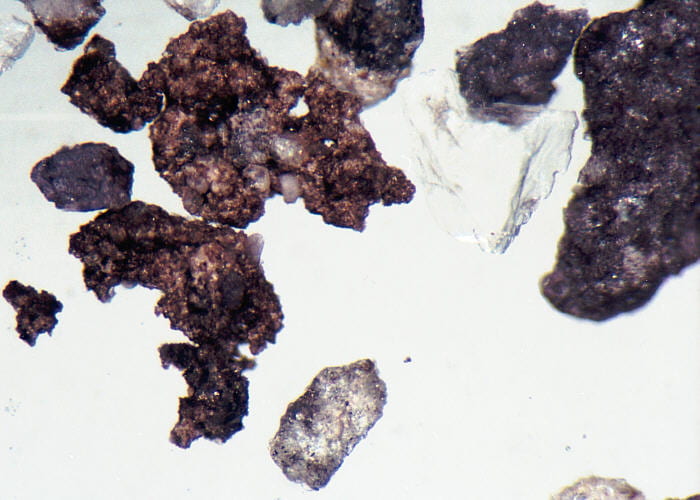
Large grains just left of center are agglutinates. These are composed of various kinds of particles welded together by glass produced by micrometeorite impacts. They typically contain bubbles that are thought to result from the degassing of implanted solar wind hydrogen and helium, and water produced by the reaction of implanted hydrogen with oxygen of the rock. Other grains include plagioclase-rich grains (top-right), and a clear plagioclase crystal (above and to the right of center). Field width is 6.3 mm.
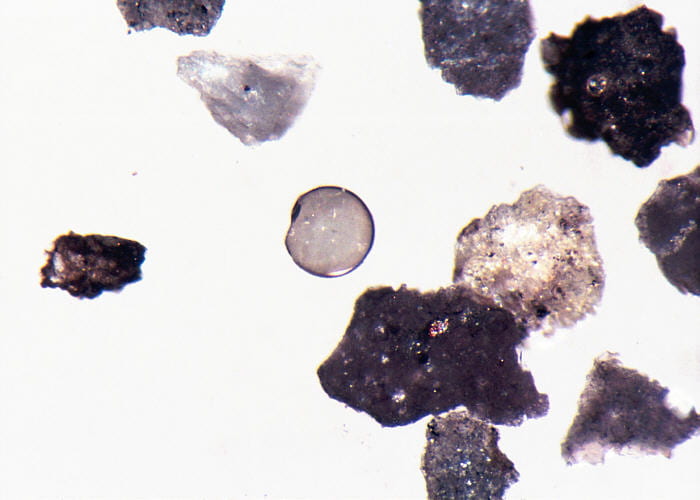
White glass sphere, probably representing a droplet of impact melt. Other grains are feldspathic igneous rocks and breccias. Field width is 5.2 mm.
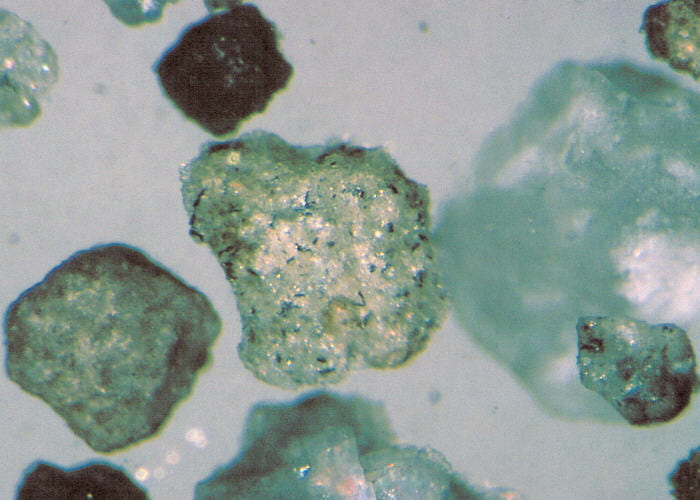
Fine-grained anorthosite fragment, with other feldspathic fragments surrounding it. Field width is 5.2 mm.
Mare regolith

Mare regolith, because it is derived from dominantly basaltic rocks, has a larger proportion of mafic minerals including fragments of olivine, pyroxene, and Fe-Ti oxides in addition to plagioclase. Green and orange glass spheres are present as well. The rough and irregular grains are agglutinates. Field width is 6.9 mm.
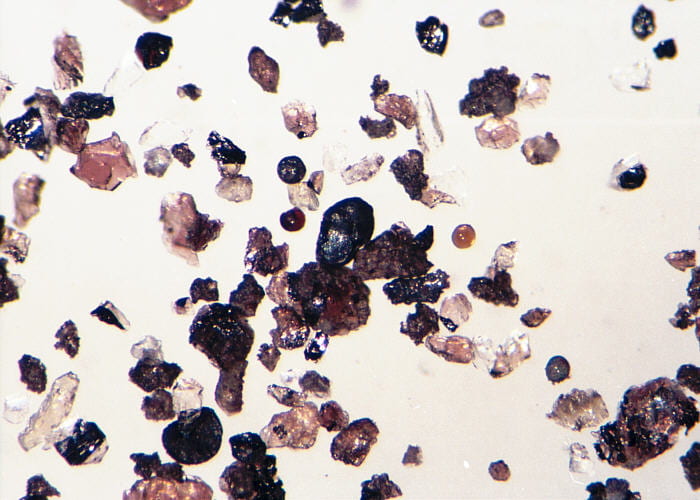
Orange glass spheres, plum-colored pyroxenes, plagioclase crystals, orange glass spheres, and agglutinate grains. Field width is 5.2 mm.
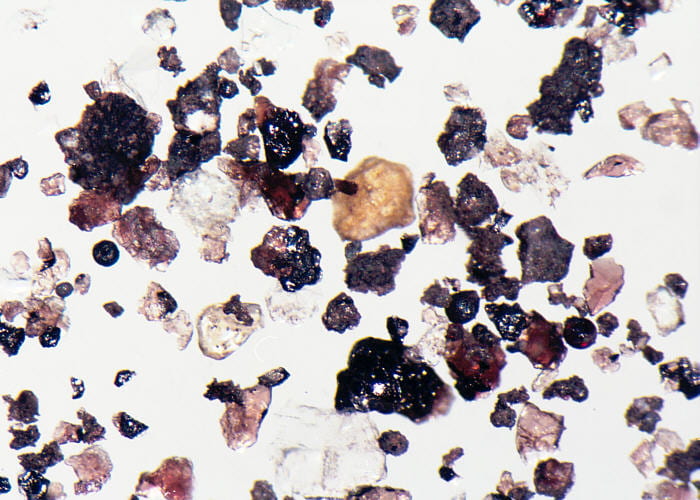
Rich assortment of mineral grains including clear plagioclase, pale-green olivine, plum-colored pyroxene, and black Fe-Ti oxides. Two modest size breccia fragments are visible (upper left), as are many small, irregular, dull dark-gray agglutinate fragments (especially top center and right) Field width is 6.3 mm.
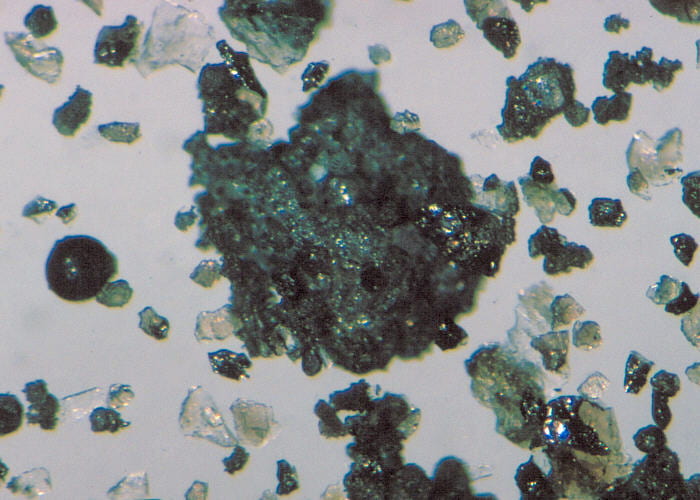
A large agglutinate particle, made of grains cemented together with micrometeorite impact glass and containing numerous vapor bubbles. Numerous mineral and polyminerallic fragments are visible, and an orange glass sphere (left center, appears black because of partial crystallization). Field width is 5.2 mm.
Breccia
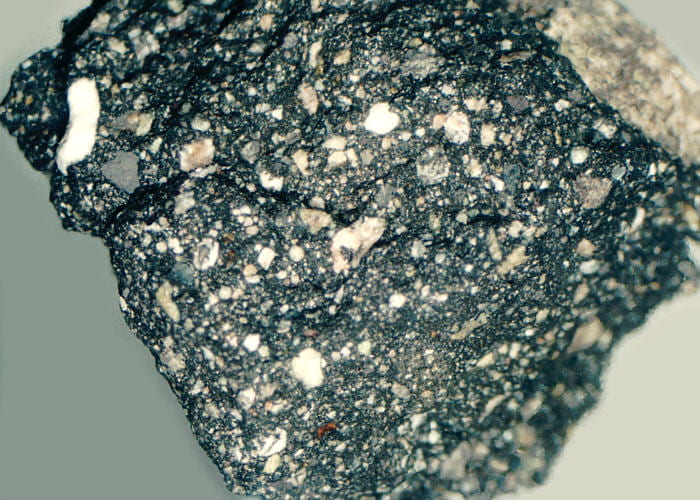
This breccia fragment has a wide variety of mineral and rock fragments embedded in a fine-grained matrix composed of finely-divided minerals and glass. It represents multiple episodes of impact fragmentation and welding. Field width is 21 mm.

Closer view of this breccia. The large light-colored grain in the lower left is an anorthositic rock fragment, and the brown grain on the right is a fractured pyroxene. Field width is 15 mm.
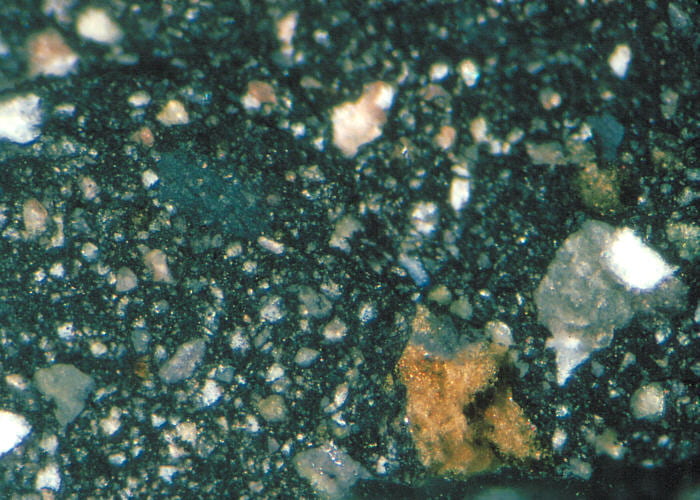
Close-up of the breccia fragment showing grains of green olivine and white plagioclase (right center) and brown pyroxene (bottom right). Other fragments include monominerallic grains, fine-grained igneous rocks, and small breccia fragments. Field width is 8.3 mm.
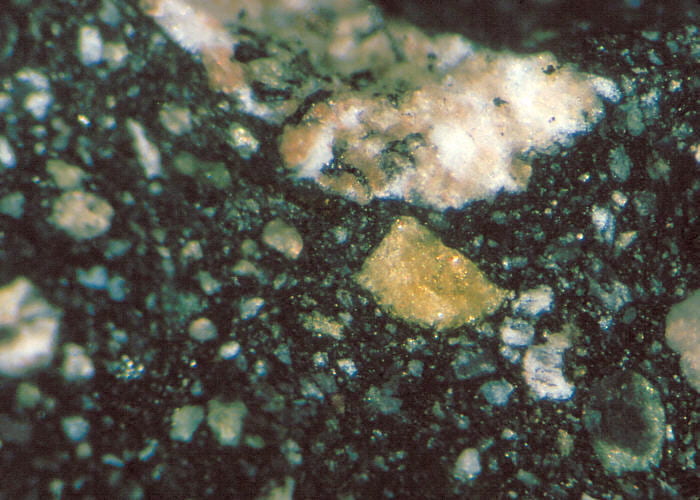
A noritic rock fragment is the large white-and-brown piece at the top, and the yellow-green piece near the center is olivine. Field width is 6.6 mm.
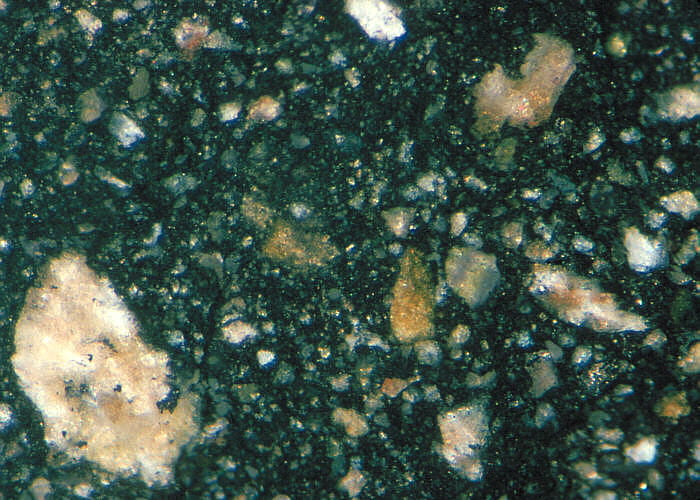
Several small white-and-brown noritic rock fragments, and one larger one (bottom left), and a yellowish-brown pyroxene grain (near center). Field width is 6.6 mm.
Orange soil

Orange soil is composed largely of orange volcanic glass beads that are thought to have been magmatic liquid that quenched during their ballistic trajectories from a fire fountain eruption. The orange color is caused by high Ti3+ concentrations. Field width is 5.2 mm.
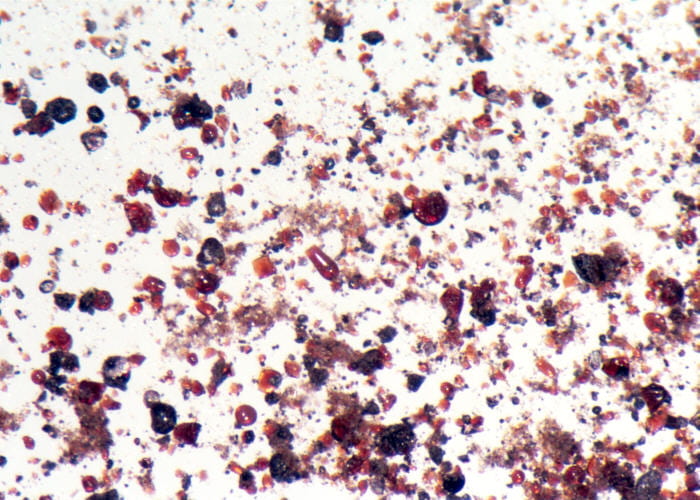
Another example of the orange soil. Only some of the beads are actually orange, others underwent partial crystallization during cooling and are black. Field width is 5.2 mm.
